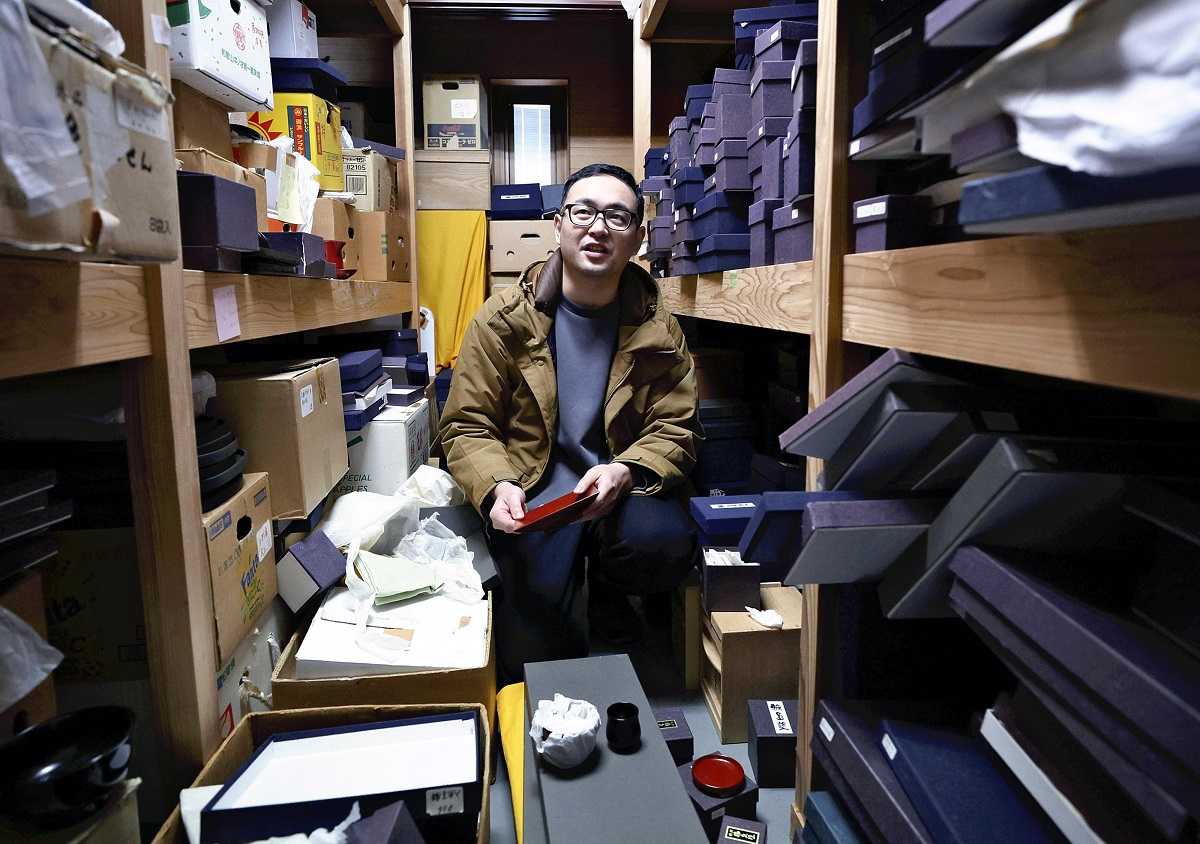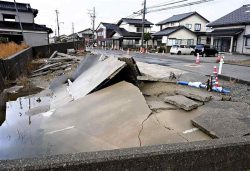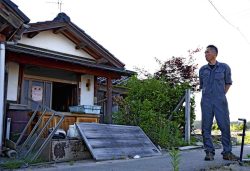Noto Quake — A Closer Look / Rebuilding Communities a Race Against Time; Survival of Traditional Crafts Under Threat

Shinya Hattori walks in his neighborhood in Suzu, Ishikawa Prefecture, on Jan. 30, which was severely damaged by the Noto Peninsula Earthquake.
2:00 JST, February 8, 2024
This is the final installment of a series examining issues that have emerged in disaster-stricken areas since the deadly Jan. 1 Noto Peninsula Earthquake.
***
It has been more than a month since the Noto Peninsula Earthquake struck Shinya Hattori’s neighborhood. With many houses still left almost collapsed and with no water supply, only six out of 40 households have remained in the community.
“The earthquake has taken away all the bonds and traditions of the community,” Hattori, 48, said with a sigh. The third-generation barbershop owner lives in a residential area about a kilometer from Suzu’s city hall in Ishikawa Prefecture.
Hattori used to teach a traditional song for the autumn festival at a local elementary school every month, but the shrine where the floats and taiko drums were kept for the festival had also collapsed in last month’s disaster.
A regular customer came to see him to say goodbye in late January. The customer had decided to leave the city to evacuate elsewhere.
Hattori sent off the customer, saying, “Please drop by again,” but he thought such a day may “never come again.”
The Okunoto region on the northern tip of the Noto Peninsula had already experienced a 20% decrease in population over the past 10 years. In the region comprising the cities of Wajima, Suzu, Noto and the town of Anamizu, half the residents are over 65 years old, and many houses are old and vacant.
The earthquake destroyed about 2,500 buildings, accounting for 40% of the city’s housing.
In Wajima where investigations are underway, 60% of the housing is believed to be either completely destroyed or partially damaged. There has been little progress in clearing away the collapsed buildings. With many households consisting only of elderly people, it is not easy to rebuild the homes at the same locations.
Nearly 8,500 people are still living in evacuation centers in the affected areas. Many more are staying with relatives or in damaged homes. Although many people wish to remain in the familiar places where they used to live, their wishes may not always come true.
Since flat land suitable for temporary housing is limited in the Okunoto region, only about 1,300 units will be built there.
Of the 18,200 apartment and public housing units to be provided by the Ishikawa prefectural government by the end of March, 11,700 units — over 60% — are located outside the prefecture.
Key industries, such as fishing, agriculture, forestry and tourism have all been devastated.
Gov. Hiroshi Hase envisions “creative reconstruction,” which was the slogan used in the aftermath of the 2011 Great East Japan Earthquake.
“Homes, communities and livelihoods need to be rebuilt together, so people can return to Noto with peace of mind,” he said.
Reconstruction of communities must proceed carefully, while obtaining the consent of local residents. On the other hand, it is a race against time. Even if roads, ports and public facilities are built at great expense, the longer it takes, the more the population drain will accelerate.
The town of Minami-Sanriku in Miyagi Prefecture, damaged by the 2011 tsunami, was rebuilt on higher ground. Rehousing was completed six years after the quake, and many residents who could not wait any longer had already left the town. As the result, the town’s population fell to about 11,700, down 33% from before the earthquake.
Mayor Jin Sato, 72, said, “We should have anticipated the population decline and kept the town compact.”
“Even so, Minami-Sanriku has risen up as a fishing town and is moving forward,” Sato said. “Noto, too, can revive if it can reconstruct the traditional culture that has taken root in the area, such as Wajima lacquerware.”
Local craft in jeopardy
The Jan. 1 earthquake severely damaged traditional crafts that have been nurtured in Noto and inherited from generation to generation.
Wajima-nuri lacquerware — an important intangible cultural property — was hit especially hard, with between 70% and 80% of the workshops and homes of the 1,000 Wajima-nuri craftspeople believed to have been destroyed, according to the Wajima city government.
Highly specialized craftspeople divide the work made up of more than 100 different processes, and missing a single step would stop production. Many craftspeople are elderly, solo proprietors, and the craft is in jeopardy.
Some rise up against the hardships. One such person is Haruhiko Daiku, 36, the seventh generation owner of Tsutaya, who is involved in lacquerware sales and planning.
His store, located 300 meters from the Wajima morning market, was spared from the fire, but products fell from the shelves, leaving the store a mess.
“In an aging industry, craftspeople may give up on their job one after another,” said Daiku, who also chairs the Wajima lacquerware youth association.
Putting his own challenges on the back-burner, Daiku called for donations with his fellow association members via X on Jan. 6. He then posted a message saying: “The summation of painstaking efforts is the characteristic of durable Wajima-nuri. We’ll survive in the midst of this disaster. So, please help the craftspeople.” The account has received messages from viewers saying, “I will support the craftspeople and buy Wajima-nuri.”
The central government proposed a support plan for traditional industries by subsidizing three-fourths — capped at ¥10 million — of the costs required to continue business, such as or the purchase of tools and raw materials. Such governmental support must continue for a long time so that as many craftspeople as possible can resume their craft.
On the one-month anniversary of the Noto Peninsula Earthquake, Gov. Hase called the Noto Peninsula “the heart of Ishikawa’s people and the unspoiled landscape of Japan” and vowed to restore its luster.
Wajima Mayor Shigeru Sakaguchi said: “Nature, tourism and culture are the heart and soul of Noto. Its revival will encourage many people.”
Protecting the region’s treasures is the key to Noto’s revival.

Haruhiko Daiku tidies up a storage room where lacquerware items are scattered about on Jan. 29 in Wajima, Ishikawa Prefecture.
"Society" POPULAR ARTICLE
-

M4.9 Earthquake Hits Tokyo, Neighboring Prefectures
-

Israeli Tourists Refused Accommodation at Hotel in Japan’s Nagano Pref., Prompting Protest by Israeli Embassy and Probe by Prefecture
-

M7.5 Earthquake Hits Northern Japan; Tsunami Waves Observed in Hokkaido, Aomori and Iwate Prefectures
-

Tsukiji Market Urges Tourists to Avoid Visiting in Year-End
-

High School in Kyoto Says Students Shoplifted during Recent School Trip to Bali, Indonesia
JN ACCESS RANKING
-

Tokyo Economic Security Forum to Hold Inaugural Meeting Amid Tense Global Environment
-

Keidanren Chairman Yoshinobu Tsutsui Visits Kashiwazaki-Kariwa Nuclear Power Plant; Inspects New Emergency Safety System
-

Imports of Rare Earths from China Facing Delays, May Be Caused by Deterioration of Japan-China Relations
-

University of Tokyo Professor Discusses Japanese Economic Security in Interview Ahead of Forum
-

Japan Pulls out of Vietnam Nuclear Project, Complicating Hanoi’s Power Plans

























